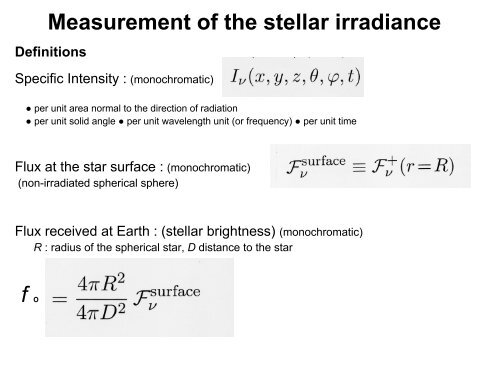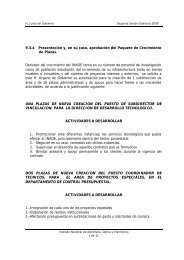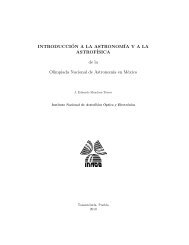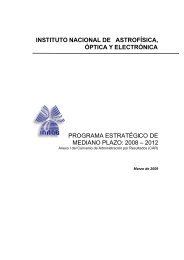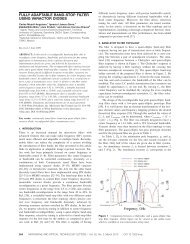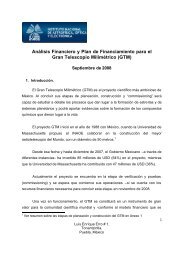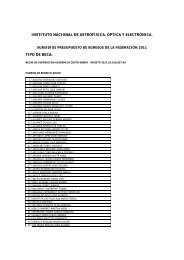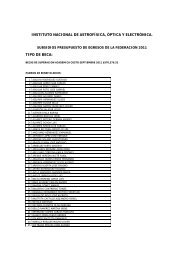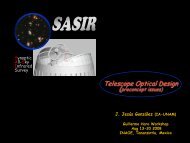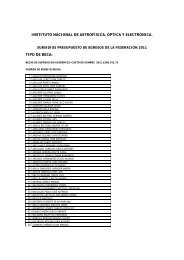Measurement of the stellar irradiance f - inaoe
Measurement of the stellar irradiance f - inaoe
Measurement of the stellar irradiance f - inaoe
Create successful ePaper yourself
Turn your PDF publications into a flip-book with our unique Google optimized e-Paper software.
<strong>Measurement</strong> <strong>of</strong> <strong>the</strong> <strong>stellar</strong> <strong>irradiance</strong><br />
Definitions<br />
Specific Intensity : (monochromatic)<br />
● per unit area normal to <strong>the</strong> direction <strong>of</strong> radiation<br />
● per unit solid angle ● per unit wavelength unit (or frequency) ● per unit time<br />
Flux at <strong>the</strong> star surface : (monochromatic)<br />
(non-irradiated spherical sphere)<br />
Flux received at Earth : (<strong>stellar</strong> brightness) (monochromatic)<br />
R : radius <strong>of</strong> <strong>the</strong> spherical star, D distance to <strong>the</strong> star<br />
f º
dA<br />
= ∆σ<br />
∆ω = dΩ
Some basic notations :<br />
(R = radius <strong>of</strong> <strong>the</strong> star, D = distance to <strong>the</strong> star)<br />
►monochromatic <strong>stellar</strong> luminosity L º = 4π R 2 surface<br />
F º<br />
►monochromatic <strong>stellar</strong> brightness E º = L º / (4π D 2 )<br />
in papers related to <strong>the</strong> calibration <strong>of</strong> <strong>the</strong> <strong>stellar</strong> brightness :<br />
E º = f º<br />
Objective :<br />
→ to mesure <strong>the</strong> <strong>stellar</strong> brightness (ie <strong>the</strong> energy disribution) over <strong>the</strong> all<br />
spectral range<br />
→ to determine <strong>the</strong> luminosity <strong>the</strong> distance being known)<br />
→ to compute Teff from <strong>the</strong> luminosity (L = 4π R 2 ¾ T 4 )<br />
for a set <strong>of</strong> “fundamental stars” (for which <strong>the</strong> radiis and <strong>the</strong> distance are known<br />
or angular diameter see after) <strong>the</strong>se stars will <strong>the</strong>n be used, in a second step,<br />
for <strong>the</strong> calibration <strong>of</strong> some selected parameters in Teff which in turn can be<br />
used to derive Teff for any star without determination <strong>of</strong> <strong>the</strong>ir distance, energy<br />
distribution or radiius.
asic recipe:<br />
to determine f º<br />
over <strong>the</strong> all spectral range for Vega<br />
(=Spectral Energy distribution SED)<br />
→ convert monochromatic magnitude <strong>of</strong> Vega into energy through<br />
absolute calibration given by black body radiation (platinum, copper)<br />
► shape <strong>of</strong> <strong>the</strong> « <strong>stellar</strong> continum » determined<br />
► plus flux intensity at some point : usually at λ = 5556 Å<br />
→cruxial role <strong>of</strong> <strong>the</strong> V-band magnitude<br />
→ convert monochromatic magnitude <strong>of</strong> any star into energy through<br />
absolute calibration given by Vega
Energy received at Earth : (<strong>stellar</strong> brightness, <strong>stellar</strong> <strong>irradiance</strong>) (monochromatic)<br />
R : radius <strong>of</strong> <strong>the</strong> spherical star, D distance to <strong>the</strong> star<br />
f º<br />
=<br />
units :<br />
monochromatic <strong>stellar</strong> <strong>irradiance</strong> not observed directly but from observations<br />
made with finite spectral bands :<br />
monochromatic magnitude :<br />
+ constant<br />
+ constant<br />
In fact one measures E m<br />
i<br />
(λ) : an heterochromatic magnitude through <strong>the</strong> filter i<br />
m i<br />
(λ) = m 0<br />
i<br />
– 2.5 log E m<br />
i<br />
(λ)<br />
m 0<br />
i<br />
is an arbritary constant (zero point <strong>of</strong> <strong>the</strong> magnitude scale through <strong>the</strong> filter i ).<br />
For <strong>the</strong> UBV system <strong>the</strong> zero points were defined as such : for an A0V type star all<br />
<strong>the</strong> color indices equal 0 and V=0 for Vega.
Methods <strong>of</strong> <strong>the</strong> flux measurements<br />
star and standard « source » observed with same telescope<br />
and equipment but not <strong>the</strong> same light path<br />
Visible flux calibration<br />
■<br />
standard sources are blackbodies (Cu, Pt etc.) and/or tungsten strip<br />
lamps, usually located on nearby mountain tops (many complications e.g<br />
horizontal extinction etc.and unaccuracies in <strong>the</strong> dta reduction)<br />
→ define a primary standard<br />
→<br />
Vega is <strong>the</strong> primary standard star in <strong>the</strong> visible<br />
(3300 – 10500 Å extended till 3.5 µ)<br />
only selected regions observed over a finite ∆λ domain (≈ 25 Å – 100 Å) no strong<br />
features<br />
■ <strong>the</strong>n definition <strong>of</strong> secondary and tertiary standard stars :<br />
stars for which <strong>the</strong>ir flux is calibrated against Vega.<br />
(fainter objects needed for large telescope, and sou<strong>the</strong>rn hemisphere observatories)<br />
Near infrared flux calibration - 3.5 µm<br />
■<br />
■<br />
blackbodies as in <strong>the</strong> visible → Vega primary standard and <strong>the</strong>n definition<br />
<strong>of</strong> secondary standard stars.<br />
solar analog stars used: <strong>the</strong>ir energy distribution is supposed to be<br />
identical to that <strong>of</strong> <strong>the</strong> Sun (Neckel &Labs, 1981, Solar Physics, 74, 231).
monochromatic magnitude <strong>of</strong> Vega (Oke & Gunn, 1983, ApJ 266, 713)<br />
- 48.6 ( AB mag )<br />
- 21.1 ( ST mag )<br />
at λ = 5480 Å, V = 0.03<br />
Survey and analysis <strong>of</strong> Vega absolute calibrations :<br />
Hayes 1985 (Symp. 111, page 225)<br />
Critical analysis on Vega calibrations in <strong>the</strong> visible and near-infrared :<br />
Mégessier 1995, A&A 296, 771<br />
→ flux at 5556 Å = 3.46 10 -11 Wm -2 nm -1 standard error 0.7%<br />
internal consistency 0.4%<br />
(value slight different compared to Oke&Gunn)<br />
→ in <strong>the</strong> near IR flux measurement uncertainty : 2-3 %<br />
standard deviation less than 2%.
primary standard → secondary standards → tertiary standards (fainter<br />
stars)<br />
for example : Oke &Gunn 1983, ApJ, 266, 713 ; Taylor, 1984, ApJ, 54, 259 ; Massey<br />
et al 1988, ApJ, 328, 315 ; Hamuy et al, 1992, PASP, 104, 533 ; Stone, 1996,<br />
ApJS, 107, 423; etc.<br />
Extention <strong>of</strong> <strong>the</strong> spectral domain covered: IR (1 – 35 µm)<br />
no observations compared to blackbodies available (see discussion in<br />
Cohen et al.,1992, AJ, 104, 1650)<br />
→ introduction <strong>of</strong> model athmospheres to calibrate<br />
Models <strong>of</strong> Kurucz (1991) for Vega and Sirius are used for absolute<br />
calibration in <strong>the</strong> IR;<br />
beyond 17µm Vega-model not used due to IR-excess <strong>of</strong> Vega<br />
→ absolutely calibrated spectrum <strong>of</strong> α Tau<br />
(Cohen et al, 1992, AJ, 104, 2030; see subsequent papers, .., 2003, AJ, 126, 1090)<br />
If model atmosphere used for fainter stars, reddening has to be taken into<br />
account (discussion on reddening laws used : 2003, Cohen AJ 125, 2645)<br />
(note: flux in <strong>the</strong> IR have been measured after <strong>the</strong> calibration <strong>of</strong> <strong>the</strong> space experiment before launch and/or<br />
using asteroides as « standards » those being considered as « black bodies » but such measurements are<br />
not as accurated as those described here, never<strong>the</strong>less, <strong>the</strong>y are used for some studies)
Cohen et al.1992, AJ, 104, 1650
Extention <strong>of</strong> <strong>the</strong> spectral domain covered : UV<br />
no black body available on board<br />
(note: flux in <strong>the</strong> UV have been measured after <strong>the</strong> calibration <strong>of</strong> <strong>the</strong> space experiment before<br />
launch and/or combining <strong>stellar</strong> model atmosphere for some stars : e.g. IUE)<br />
→ based on model atmosphere <strong>of</strong> WD <strong>of</strong> nearly pure hydrogene<br />
atmosphere (featureless objects), tight on <strong>the</strong> Vega flux scale through <strong>the</strong><br />
V-mag in <strong>the</strong> visible (e.g. Bohlin, 2000, AJ, 120, 437)<br />
HST absolute spectrophotometry <strong>of</strong> Vega from 0.17 to 1.01 µm .<br />
(Bohlin & Gilliland, 2004, AJ, 127, 3508)<br />
Vega STIS observations calibrated with standard WD stars<br />
♦ good comparison with Hayes flux (standard lamps) in <strong>the</strong> visible<br />
♦ excellent agreement with <strong>the</strong> Kurucz (2003) model in <strong>the</strong> visible,<br />
http://hurucz.haward.edu/stars/vega<br />
♦ some discrepancies in <strong>the</strong> UV and in <strong>the</strong> Balmer lines region.
Ratio <strong>of</strong> <strong>the</strong> final STIS fluxes for Vega to those <strong>of</strong> Hayes<br />
(1985). The revised monochromatic flux <strong>of</strong> Megessier<br />
(1995) at 5556 Å is shown by <strong>the</strong> filled circle.
Comparison <strong>of</strong> <strong>the</strong> STIS model (black) with <strong>the</strong> Kurucz (2003) model<br />
(red) that has effective temperature 9550 K and log g = 3.95 from H<br />
to H . The observations and <strong>the</strong>ory agree to 1%.
Comparison as in Fig. 6 for <strong>the</strong> Balmer continuum region.<br />
Systematic differences <strong>of</strong> up to 3% are prevalent. The top panel<br />
has an expanded vertical scale in comparison with <strong>the</strong> bottom<br />
panel.
Comparison in <strong>the</strong> UV below 2800 Å, where <strong>the</strong>re is an<br />
excellent correlation in <strong>the</strong> wavelengths <strong>of</strong> <strong>the</strong> detailed<br />
spectral features. However, <strong>the</strong> model <strong>of</strong>ten shows an excess<br />
<strong>of</strong> metal-line blanketing by up to several percent.
Catalogues <strong>of</strong> SED<br />
Jacoby et al, 1984 ApJS, 56, 257<br />
Gunn & Stryker, 1983 ApJS. 52, 121<br />
Glushneva et al. 1998, etc.<br />
Kharitonov et al. 1998, etc.<br />
Calibration <strong>of</strong> spectra (e.g.Prugniel & Soubiran, 2001, A&A, 369, 1048)<br />
IUE spectra<br />
http://www.ucm.es/info/Astr<strong>of</strong>./spectra.html<br />
etc.<br />
Discussion on methods for calibrating spectrophotometry :<br />
Bessell, 1999, PASP, 111, 1426
Absolute flux calibration <strong>of</strong> photometry<br />
Heterochromatic observations will give few points <strong>of</strong> <strong>the</strong> SED<br />
A photometric system is defined by <strong>the</strong> magnitudes and color indices <strong>of</strong> « standard<br />
stars » (for that system)<br />
For « standard stars » with a SED computed :<br />
F* = SED , S = response <strong>of</strong> <strong>the</strong> instrument for each pass-band <strong>of</strong> <strong>the</strong> system<br />
<strong>the</strong> raw flux observed for that star is : F = 10 -0.4 m<br />
m is <strong>the</strong> magnitude mesured through a filter.<br />
F’ / F gives <strong>the</strong> conversion factor to obtain monochromatic flux for any o<strong>the</strong>r star<br />
at a wavelength defined by:<br />
The « standard stars » can be reduced to one : Vega<br />
(e.g. uvby Strömgren system : Gray, 1998, AJ, 116, 482)<br />
Remark : <strong>the</strong> effective wavelength is also defined as :<br />
f = <strong>stellar</strong> flux, R V = reponse <strong>of</strong> <strong>the</strong> system in <strong>the</strong> V-band;<br />
for Vega λ eff<br />
is 5448 Å; for <strong>the</strong> Sun it is 5502 Å
Some results<br />
uvby photometry :<br />
Comparison between<br />
spectrophotometry (open<br />
circles) for stars over a<br />
wide range <strong>of</strong> spectral<br />
types and <strong>the</strong> final<br />
calibration <strong>of</strong> Gray,1998<br />
(filled circles).<br />
The point for <strong>the</strong> v<br />
band falls below <strong>the</strong><br />
continuum because <strong>of</strong><br />
<strong>the</strong> presence <strong>of</strong> Hδ in<br />
<strong>the</strong> filter.
Strömgren photometric system
Zero-point <strong>of</strong> syn<strong>the</strong>tic photometric systems<br />
Principle : computed magnitude should be equal to <strong>the</strong> observed ones for<br />
« standard stars » (if atmosphere models correct) at least one star: Vega<br />
→ zero-point has to be determined in order to compare observations to some finding<br />
out from models (e.g. isochrones)<br />
(e.g. broadband UBVRIJHKL system: Bessell , 1998, A&A, 333, 231)<br />
Zero-point for V-band defined with Vega model (Castelli & Kurucz, 1994)<br />
problems :<br />
stability <strong>of</strong> R from one observatory<br />
to ano<strong>the</strong>r.<br />
non-linear transformation over <strong>the</strong> all<br />
Teff range.<br />
reddenning effect on energy distribution<br />
luminosity effect.<br />
etc.<br />
→ subject still in progess
Some results<br />
The <strong>the</strong>oretical U-B versus B-V<br />
diagram is plotted for log g=4.0<br />
and 4.5 for and for log g=4.5<br />
and 5.0 for (crosses). It is<br />
compared with <strong>the</strong> observed<br />
unreddened dwarf locus.<br />
(Bessell , 1998, A&A, 333, 231)
What is<br />
measured ?<br />
Heterochromatic magnitude
+ …..
Heterochromatic extinction : effect <strong>of</strong> <strong>the</strong> pass-bands.<br />
Atmospheric extinction : Burki et al A&AS, 112, 383, 1995 Warning !
Inter<strong>stellar</strong> extinction
A(λ=V)<br />
R = --------------------<br />
E(B-V)<br />
Parametrization <strong>of</strong> <strong>the</strong> extinction curves :<br />
Cardelli et al ApJ 345,245, 1989<br />
Fitzpatrick PASP, 111, 63, 1999<br />
DIB = Diffuse Inter<strong>stellar</strong> Bands
Maps used to determine<br />
<strong>the</strong> reddening <strong>of</strong> a star if its<br />
distance is estimated<br />
calibration means<br />
here values <strong>of</strong> color<br />
indices for “normal”<br />
non-reddened stars
( from: B. Chen at al A&A 336, 137, 1998)<br />
Extinction computed from <strong>the</strong> reddening <strong>of</strong> open clusters as given in <strong>the</strong><br />
data base (Mermilliod 1992 – Geneva Observatory)<br />
The accuracy <strong>of</strong> such map will be improved with GAIA observations<br />
(Chen et al. 1999BaltA...8..195)<br />
The inter<strong>stellar</strong> extinction is <strong>of</strong> crucial<br />
importance on many fields <strong>of</strong> optical<br />
astronomy. However, <strong>the</strong> 3-dimensional<br />
distribution <strong>of</strong> <strong>the</strong> extinction is only known in<br />
<strong>the</strong> solar neighbourhood.<br />
FitzGerald (1968) maps inter<strong>stellar</strong> extinction<br />
using color excesses <strong>of</strong> 7835 O to M stars.<br />
Neckel & Klare (1980) derived extinctions<br />
and distances for more than 11000 stars and<br />
investigated <strong>the</strong> spatial distribution <strong>of</strong> <strong>the</strong><br />
inter<strong>stellar</strong> extinction at low galactic latitude .<br />
Using a larger sample (about 17000 stars)<br />
with MK spectral types and photoelectric<br />
photometry, Arenou et al. (1992) published<br />
an extinction model in which <strong>the</strong> sky was<br />
divided into 199 cells. Recently, Méndez &<br />
van Altena (1998) and Chen et al. (1998)<br />
have constructed inter<strong>stellar</strong> extinction<br />
models <strong>of</strong> <strong>the</strong> solar neighbourhood.<br />
All extinction models mentioned above are<br />
valid not far away from <strong>the</strong> Sun (r < 2 kpc).<br />
Recently, Schlegel et al. (1998) published a<br />
full-sky map <strong>of</strong> <strong>the</strong> Galactic dust based upon<br />
its far-infrared emission (IRAS) The spatial<br />
resolution is about 6.1 arcmin . Chen et al<br />
(A&A, 352, 459, 1999) propose a new 3-<br />
dimensional extinction model based on <strong>the</strong><br />
COBE/IRAS reddening map, extended to low<br />
galactic latitude regions.
Exemple <strong>of</strong> de-reddening :<br />
Ramírez & Meléndez, 2005, ApJ, 626,446


